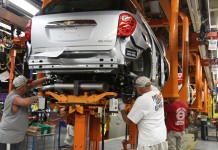General Motors has given the wheel of the troubled auto giant to Ed Whitacre, who agreed to become permanent chief executive in addition to chairman as he pledged to speed repayment of government loans.
Whitacre on Monday accepted a board request to become permanent CEO at the struggling US auto giant after stepping in as interim chief executive following the resignation of Fritz Henderson last December.
“Having spent the past few months learning the business, meeting with our employees, customers and dealers, and working with the GM leadership team, I was both honored and pleased to accept this role,” he told a press conference at GM headquarters in Detroit.
“This is a great company with an even greater future, and I want to be part of it,” he said.
GM entered into bankruptcy protection on June 1 last year with liabilities of 172.8 billion dollars and 48.4 billion in debt.
Whitacre expressed the GM board’s commitment that the company would pay back in full the US Treasury and the Canadian and Ontario government loans by June.
“We’ve made significant progress in the past couple of months, so much so that I can confirm with certainty that we will pay back in full the US Treasury and Canadian and Ontario government loans by June,” Whitacre said.
“This represents a significant milestone in our journey back to being a profitable and viable company.”
The Treasury Department said separately Monday that it had received a commitment from GM to repay its government debt in full in June — “well ahead of the original repayment schedule.”
GM will be required to repay the full 6.7 billion dollar investment made under the government’s Troubled Asset Relief Program (TARP) along with 1.4 billion dollars in repayments to the Canadian and Ontario governments by June 30,” a Treasury statement said.
The TARP was part of a 700-billion-dollar government bailout approved in October 2008 to prevent the financial system, especially banks, from collapse following a crisis arising from a home mortgage meltdown.
General Motors received 49.5 billion dollars in government aid amid its spectacular collapse.
Much of that aid was converted into stock in the new company which emerged from bankruptcy protection in July.
The US government obtained a 61 percent stake, the Canadian government received an 11.7 percent stake, a United Auto Workers union retiree trust fund received a 17.5 percent stake and bondholders received a 10 percent stake.
Ron Bloom, the auto czar in President Barack Obama’s administration, said Monday that GM could launch an initial public offer of its shares this year.
“That will obviously remain dependent on how markets are, how the company can still make progress on the restructuring,” he said, adding that only part of the government ownership could be sold to the public.
“At that stage, we would expect to sell some of our ownership. We do not think it’s practical to sell our 60.8 percent at one fell swoop.”
Whitacre, a former chairman and CEO of telecom giant AT&T, was installed last year as chairman of the new company board controlled in large part by the US government under GM’s bankruptcy plan.
Some analysts say Whitacre has proven to be effective head.
“His biggest challenge will be to break GM?s silo thinking, and he is off to a good start,” commented Jeremy Anwyl, chief executive of automotive Web site Edmunds.com.
Whitacre was described in a recent Wall Street Journal report as a hard-charging Texan with a penchant for killing rattlesnakes for sport.
He is known for taking over companies and imposing his will on its employees, starting at the top, the report said.
Henderson, who took the helm at GM in late March last year as the auto giant was headed toward bankruptcy, had replaced Rick Wagoner, who was forced out of the job by the Obama administration.
Once the world’s largest corporation, General Motors sold more vehicles than any other automaker from 1931 through 2007, after which it lost the crown to Japan’s Toyota.







